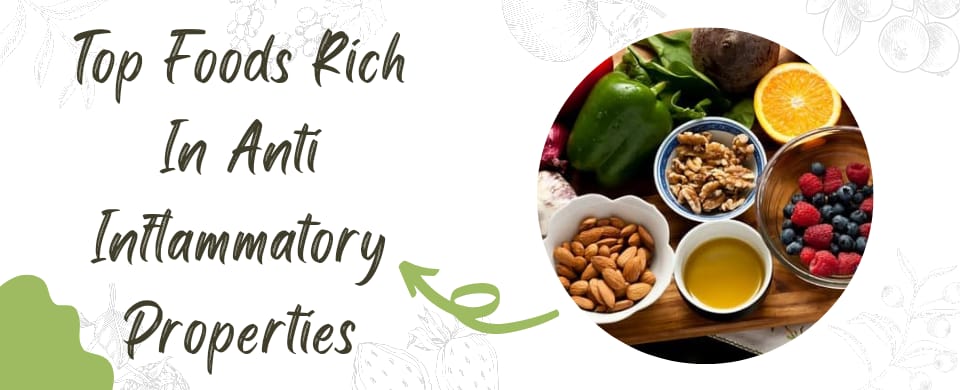Our body has a built-in defence system that fights off any foreign substances that enter it, such as viruses, germs, and toxins. This process is inflammation. It helps in maintaining our health. When you cut your finger, it swells and turns red. Your knee becomes swollen and irritated after getting wounded. This is fine.
A small amount of inflammation helps in the healing process, but when it persists for an extended period of time, it might start disease processes. The immune system might occasionally overreact and begin attacking the healthy tissues and cells.
Chronic inflammation plays a big role in nearly every serious major illness, including heart disease, cancer, Alzheimer’s disease, and depression. It can harm your heart, brain, and other organs.
Adding anti-inflammatory foods to your diet to help your body balance inflammation is one of the most effective strategies to fight it. These foods have polyphenols and natural antioxidants that function as protective elements and can help lower inflammation levels.
In this blog, I will tell you about the foods rich in anti-inflammatory properties. So, let’s get started!
Here is the list foods that are rich in anti Inflammatory properties:
Turmeric
A beautiful spice that is also an effective anti-inflammatory food item. Turmeric has curcumin that helps in naturally decreasing inflammation. It has been discovered to be extremely beneficial in the treatment of asthma, irritable bowel syndrome, inflammatory bowel disease, and even arthritis. Pain, swelling, or redness can all be symptoms of an inflammatory condition. The anti-inflammatory properties of Turmeric help in the relief of these symptoms.
Green Tea
Green tea is a well-known powerful antioxidant because of its high catechin polyphenol content. It is plentiful in anti-inflammatory flavonoids that scavenge potentially harmful free radicals. These green tea active ingredients may stop free radicals and prevent the overproduction of inflammatory chemicals, so protecting against cellular harm.
Almonds and walnuts
Omega-3 fatty acids, which reduce inflammation, are plentiful in walnuts. Walnuts contain specific enzymes that prevent the production of neurotransmitters that cause pain and swelling. Alpha-linolenic acid and phenolic antioxidants, which help in the fight against free radicals, are also abundant in them. You can eat almonds as well. According to a study, Almonds have a higher concentration of anti-inflammatory vitamin E than other tree nuts.
Figs
Figs or Anjeer have flavonoid luteolin that inhibits the activity of inflammatory cells. Another flavonoid found in figs is quercetin. Free radicals produced by chronic inflammation in your body may stimulate the release of inflammatory cells that may attack healthy cells. As a result of quercetin’s antioxidant properties, this cycle of inflammation can be broken, potentially lowering your risk of high blood pressure, heart disease, and high cholesterol.
Berries and other foods with a low GI(Glycemic Index)
Antioxidants found in raspberries, blueberries, and strawberries efficiently combat inflammation. Pick seasonal fresh berries, or if none are available, pick frozen ones. Strawberry has a good amount of Vitamin C and blueberry is a superfood that is high in both Potassium and Vitamin C. Consider incorporating these into a smoothie, such as the Coconut Blueberry Smoothie. Peaches, Apples, Pears, Plums, Oranges, and Pomegranate are other low GI fruits. These are abundant sources of carotenoids and flavonoids, two powerful antioxidants.
Green Leafy Vegetables
Leafy vegetables are excellent anti-inflammatory foods, particularly the dark green spinach leaves. Vitamins A, E, and K, which are powerful antioxidants, are incredibly abundant in spinach. These nutrients can shield your body from the oxidative stress brought on by free radical damage. Vitamin E protects the body from pro-inflammatory molecules called cytokines, which promote inflammation. Additionally, dark veggies like kale and broccoli have higher levels of fibre, iron, calcium, and more disease-preventive phytochemicals than light-colored vegetables.
Ginger, Garlic, and Onions
Garlic and onion both have powerful anti-inflammatory properties. Sugar cravings are reduced and blood sugar is controlled by onions. You can add thinly sliced raw onions to your salads. Onions can also be used together with the garlic to treat colds. Sulphur molecules found in garlic help to boost the immune system. The anti-inflammatory properties of ginger have also been used traditionally. This popular food item offers a wide range of therapeutic advantages, from relieving stomach troubles to specific types of cancer.
Whole Grains
By consuming more whole grains than refined, cereal, white bread, rice, and pasta, you can lessen the risk of developing severe inflammation. This is so because whole grains have more fiber, protein, and B vitamins. Whole grains digest slowly and have a low glycemic index. They help to maintain stable blood sugar levels. Have a lot of jowar, bajra, and brown rice. Try the mixed vegetable salad and barley khichdi.


